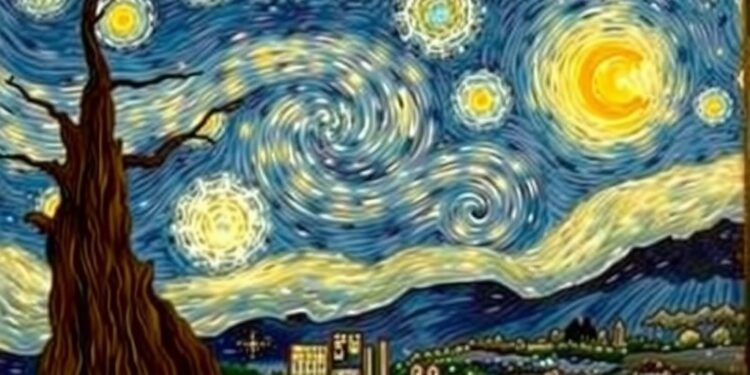RICHMOND, Va. (April 1, 2025) – Among the pantheon of Western art, Vincent van Gogh’s "The Starry Night" stands as a beacon of emotional depth and innovative style, captivating audiences for over a century. However, recent attempts to assign a scientific weight to this timeless masterpiece through the lens of fluid dynamics have stirred considerable debate. Researchers from Virginia Commonwealth University and the University of Washington have delved deep into this discourse, questioning the legitimacy of applying Kolmogorov’s turbulence theory to van Gogh’s painting.
Vincent van Gogh, whose artistic legacy was both tragic and revolutionary, created "The Starry Night" during a turbulent period in his life while residing in an asylum in Saint-Rémy-de-Provence, France. The swirling night sky illustrated in this painting echoes not just the emotional storms van Gogh faced, but also evokes a sense of chaotic beauty that has piqued the interests of artists and scientists alike. This narrative, however, veers into contentious territory when researchers attempt to quantify the artwork’s swirling patterns through the principles of fluid dynamics.
The spotlight shone brightly on a paper published in the September issue of "Physics of Fluids" last year, titled “Hidden Turbulence in van Gogh’s ‘The Starry Night’.” The authors of this paper posited that the ebullient swirls and eddies in the painting could be interpreted through Kolmogorov’s turbulence theory. This scientific framework seeks to explain how turbulent flows, such as those in the atmosphere or in oceans, exhibit complex yet predictable behaviors. The claim proposed that van Gogh’s brushstrokes mirrored the eddies found in nature, leading to a captivating intersection between art and physics.
However, the intrigue is quickly followed by claims of inaccuracy by eminent researchers in the field of fluid dynamics. Mohamed Gad-el-Hak, the Inez Caudill Eminent Professor at VCU’s Department of Mechanical and Nuclear Engineering, together with James J. Riley, Paccar Professor of Mechanical Engineering at the University of Washington, asserts that the connection drawn between fluid turbulence and the art piece is fundamentally flawed. Their recent publication in the "Journal of Turbulence," titled "Is There Hidden Turbulence in Vincent van Gogh’s ‘The Starry Night’?" provides a detailed critique of the original paper, arguing that it misapplies established turbulence theories to a medium that cannot be captured analytically.
The criticism hinges on a crucial point: Kolmogorov’s turbulence theory is rooted in the study of velocity fields within fluid flows, which requires identifiable measurable parameters, such as temperature or fluid density. Yet, these conditions are inherently absent in a painting, a medium defined by its colors and emotional resonance rather than by measurable physical properties. Gad-el-Hak highlights that drawing parallels between brush strokes and turbulence requires a significant empirical foundation, absent in the context of art.
Moreover, the atmospheric flow field assumed in the original analysis does not align with the complexities and subtleties of van Gogh’s work. Riley succinctly reinforces this argument, explaining that artistic creations encapsulate emotional and subjective experiences which inherently resist quantification through scientific principles. Van Gogh’s distinct style, particularly the curvature of lines in "The Starry Night," does not adhere to the rigid structures expected in turbulence research, as the very essence of art transcends those physical properties.
What these critiques illuminate is a broader philosophical conversation about the intersection of art and science. While the allure of deriving scientific explanations from artistic expressions can be compelling, the core of artistic creation often lies deeply embedded in personal narratives and intangible emotions that cannot be measured by the metrics of science. "The Starry Night," in its swirling chaos, serves as an embodiment of the mental tumult van Gogh experienced, veering into territories that are inherently subjective.
Art endows audiences with an emotional landscape, allowing for varied interpretations that defy rigid scientific classifications. Van Gogh’s expressive brushwork commands attention not merely due to its visual composition but because of the story it tells—a visceral experience encapsulating human suffering and transcendence. This distinction between measurable phenomena and personal expression is crucial when engaging with art through a scientific lens.
The researchers argue that rather than probing for scientific explanations, we should embrace the painting for its artistic genius. "The Starry Night" is not just an observation of turbulent skies but rather a translation of the artist’s emotional landscape into visual form, a testament to his ability to convert personal chaos into something beautifully coherent. This quality renders the painting timeless and returns us to the essence of why art holds profound significance in society.
In conclusion, the debates surrounding van Gogh’s work serve to enrich our understanding of both art and science, each domain possessing its unique merits and limitations. The beauty of "The Starry Night" lies in its abstraction, a mystique that can ignite discussion and provoke thought without needing verification through scientific frameworks. Consequently, the conversation should propel us toward greater appreciation of artistic mastery rather than a shallow endeavor to itemize it under scientific classifications.
As such, this dialogue not only honors Van Gogh’s legacy but invites us all to reflect on the unmeasurable complexities of human creativity. Far beyond swirl patterns or turbulent motion, "The Starry Night" stands as a poignant reminder of the power of art to convey the human experience—one that can enchant, provoke, and inspire without needing a scientific basis for its beauty.
Subject of Research: The intersection of art and fluid dynamics through Vincent van Gogh’s "The Starry Night."
Article Title: Is There Hidden Turbulence in Vincent van Gogh’s ‘The Starry Night’?
News Publication Date: April 1, 2025
Web References: Physics of Fluids
References: "Is There Hidden Turbulence in Vincent van Gogh’s ‘The Starry Night’?" Journal of Turbulence, 28-Jan-2025.
Image Credits: Not applicable.




